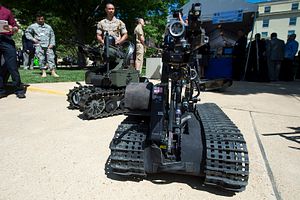When a magnitude 6.6 earthquake hit Lushon County, in China’s Sichuan province two years ago, burying dozens of towns in rubble, some of the first rescuers that survivors might have seen through the debris were not humans, but small, unmanned vehicles sent by the military to sift through the rubble. Sichuan is far from the only place where robots have been employed in disaster relief efforts: drones powered by Canadian teams have been buzzing Nepal constantly over the past few weeks, in efforts to locate survivors and victims in the aftermath of the 7.8 earthquake on April 25 which claimed over 8,500 lives.
Now, the Pentagon wants to develop autonomous robots capable of accessing disaster relief zones otherwise off limits to humans – such as the Fukushima Daiichi nuclear power plant in Japan. In June, the Defense Advanced Research Projects Agency (DARPA), Arlington’s advanced tech research hub, will host an international robotics competition – a $3.5 million race for the prize that will allow robots to square off in an obstacle course simulating a disaster site. That’s part of more than $100 million that DARPA has invested to develop robots that can be deployed in the wake of humanitarian crises. Who else is splurging to build them?
Increasingly, robots are moving from the gear shop out into the field. Lockheed Martin, a U.S. defense manufacturer based in Bethesda, Maryland, along the Capital Beltway, has pulled together a team of engineers to develop Leo, a man-sized autonomous robot with laser vision, the ability to sift rubble, cut holes in walls, open doors, and navigate stairs. Leo will soon be deployed to an in-house boot camp to work with a platoon of droids.
Other robots are being developed for strictly military purposes. With conflict still raging in Eastern Ukraine, Russia has also been ramping up tests. Uran battle robots, wielding machine guns and anti-tank guided missiles passed through a battery of drills at a training ground in Southern Russia last week, attended by Defense Minister Sergei Shoigu. A state-owned company, Rostec, is also deep into the development of a tracked robot platform capable of conducting military strikes, clearing mines, and venturing into areas impacted by radiation.
China is no stranger to robots either: last month’s Zhuhai arms show was a humanoid extravaganza that featured the “Sharp Claw,” a two-ton robotic scout with a built-in quadcopter and all-terrain driving capabilities. The age of Reaper and Predator drones is beginning to feel like ancient history. As many as 87 countries have tested robots that could eventually be used on the battlefield, and 40 nations are actively doing so.
But the rapid development of disaster and battlefield-ready robots has left the United Nations and human rights groups uneasy. Two years ago, the U.N.’s special rapporteur, Christof Heyns, called for a ban on the development of combat-ready robots, and last month, the organization hosted a conference that weighed some of the legal questions raised by autonomous weapons. Anti-robot campaigns have been embraced by NGOs like Human Rights Watch, the International Committee for Robot Arms Control, and the Campaign to Stop Killer Robots. Most Americans oppose the use of autonomous robots in combat, according to a University of Massachusetts-Amherst poll released in 2013.
The ball on autonomous and semi-autonomous weapons systems, however, is already rolling. The list of groups competing in next month’s competition ranges from Boston Dynamics to Carnegie Mellon University and NASA. Google, whose Schaft robot won the competition two years ago, has pulled out, but there is plenty of young talent waiting in the wings, ready to steal the spotlight. The Pentagon already deploys 11,000 UAVs and over 12,000 ground robots. Don’t be surprised if they’re the ones that save the day when the next big disaster strikes.

































